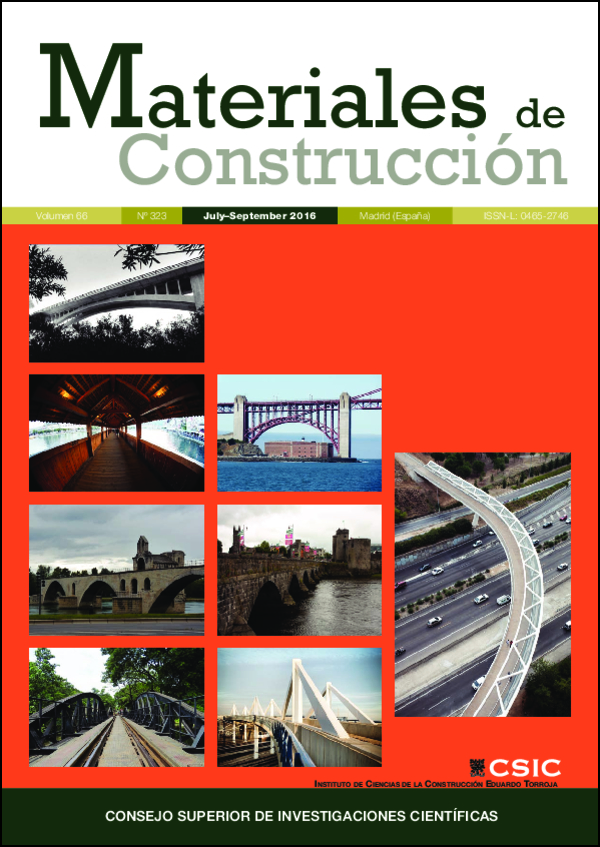The influence of water saturation on mechanical properties of ceramic bricks – tests on 19th- century and contemporary bricks
DOI:
https://doi.org/10.3989/mc.2016.07315Keywords:
Brick, Mechanical properties, Compressive strengthAbstract
The paper presents test results concerning ceramic bricks produced in 1880’s. Bricks were obtained from a building erected as part of Archduke Rudolf barracks in Krakow. The tests helped to specify changes in brick compressive strength and hardness, caused by water saturation in the ceramic material. For comparison purposes, tests were also carried out on contemporary bricks. Tests showed that mechanical properties of the ceramic bricks in the water saturation state were worse than in the dry state. The impact of strong brick moisture on changes of mechanical parameters is essential in terms of safety assessment for brick structures.
Downloads
References
1. Foraboschi, P.; Vanin, A. (2014) Experimental investigation on bricks from historical Venetian buildings subjected to moisture and salt crystallization. Eng Fail Anal. 45, 185-203. http://dx.doi.org/10.1016/j.engfailanal.2014.06.019
2. Witzany, J.; Cejka, T.; Zigler, R. (2010) The effect of moisture on significant mechanical characteristics of masonry. Eng Struct Technol. 2, 79-85. http://dx.doi.org/10.3846/skt.2010.11
3. Matysek, P.; Witkowski, M. (2013) The assessment of humidity impact on the strength of brick masonry. Build Mater. 5, 10-12 [in Polish].
4. Amade A.M.; Martin J.V.; Colville, J. (2004). The effect of moisture on compressive strength and modulus of brick masonry. Proc. 13th International Brick and Block Masonry Conference. Amsterdam. PMid:15043442
5. Cultrone, G.; Sebastián, E.; de la Torre, M.J. (2005) Mineralogical and physical behaviour of solid bricks with additives. Constr Build Mater. 19, 39-48. http://dx.doi.org/10.1016/j.conbuildmat.2004.04.035
6. Elert, K.; Cultrone, G.; Navarro, C.R.; Pardo, E.S. (2003) Durability of bricks used in the conservation of historic buildings - influence of composition and microstructure. J Cult Herit. 4, 91-96. http://dx.doi.org/10.1016/S1296-2074(03)00020-7
7. Cultrone, G.; Sebastian, E.; Elert, K.; de la Torre, M.J.; Cazallo, O.; Navarro, C.R. (2004) Influence of mineralogy and firing temperature on the porosity of bricks. J Eur Ceram Soc. 24, 547-564. http://dx.doi.org/10.1016/S0955-2219(03)00249-8
8. Fernandes, F.M.; Lourenco, P.B.; Castro, F. (2010) Ancient clay bricks: manufacture and properties. In: Bostenaru Dan M; P?ikryl R; Török Á. Materials, Technologies and Practice. Historic Heritage Structures, Springer, (2010). http://dx.doi.org/10.1007/978-90-481-2684-2_3
9. Egermann, R.; Mayer, K. (1988) Die Entwicklung der Ziegelherstellung und ihr Einfluss auf die mechanischen Eigenschaften von Mauerziegeln. In: Erhalten historisch bedeutsamer Bauwerke - Baugefu -ge, Konstruktionen, Werkstoffe, Sonderforschungsbereich 315, Universit‰t Karlsruhe, Ernst und Sohn, Berlin, (1988).
10. Franke, L.; Schumann, I. (1998) A brief history of brickmaking in Northern Germany. In: Bear NS, Livingston RA, Fitz S. Conservation of Historic Brick Structures, United Kingdom: Donhead Publishing Ltd.
11. Nadachowski, F.; Jonas, S.; Wodnicka, K. (2003) Outline of Ceramography. Ceramics 82. PAN in Cracow and Polish Ceramic Society, Cracow (2003). [in Polish]
12. Hamilton, A.; Hall, C.; Pel, L. (2008) Sodium sulfate heptahydrate: direct observation of crystallization in a porous material. J Phys D Appl Phys. 41, (212002), 1-5. http://dx.doi.org/10.1088/0022-3727/41/21/212002
13. Stryszewska, T. (2014) The change in selected properties of ceramic materials obtained from ceramic brick treated by the sulphate and chloride ions. Constr Build Mater. 66, 268-274. http://dx.doi.org/10.1016/j.conbuildmat.2014.05.066
14. Benavente, D.; Linares-Fernandez, L.; Cultrone, G., Sebastian, E. (2006) Influence of microstructure on the resistance to salt crystallization damage in brick. Mater Struct. 39, 100-113.
15. Larsen, E.S.; Nielsen, C.B. (1990) Decay of bricks due to salt. Mater Struct. 23, 16 25. http://dx.doi.org/10.1007/BF02472994
16. Lubelli, B.; van Hees, R.; Grootb, J.W.P. (2004) The role of sea salts in the occurrence of different damage mechanisms and decay patterns on brick masonry. Constr Build Mater. 18, 119-124. http://dx.doi.org/10.1016/j.conbuildmat.2003.08.017
17. Monteiro, S.N.; Vieira, C.M.F. (2014) On the production of fired clay bricks from waste materials: A critical update. Constr Build Mater. 68, 599-610. http://dx.doi.org/10.1016/j.conbuildmat.2014.07.006
18. Cultrone, G.; Sebasti·n, E. (2009) Fly ash addition in clayey materials to improve the quality of solid bricks. Constr Build Mater. 23, 1178 1184. http://dx.doi.org/10.1016/j.conbuildmat.2008.07.001
19. Stryszewska, T. (2014) The influence of full water saturation on selected physico-mechanical properties of ceramic bodies. Ceram Mater. 66 [1], 81 87 [in Polish].
20. EN 772-1. Methods of tests for masonry units - determination of compressive strength. 2001.
21. Stryszewska, T. (2012) Selection of the diagnostic features of the studies the impact of water-soluble salts on the durability of ordinary bricks. Build Mater. 5, 69-71 [in Polish].
22. Sitarz, M. (2011) The structure of simple silicate glasses in the light of Middle Infrared spectroscopy studies. J. Non-Crystalline Solids 357, 1603-1608. http://dx.doi.org/10.1016/j.jnoncrysol.2011.01.007
23. Mozgawa, W.; Sitarz, M.; Rokita, M. (1999) Spectroscopic studies of different aluminosilicate structures. J. Molecular Structure 251, 511-512. http://dx.doi.org/10.1016/s0022-2860(99)00165-9
24. Awgustinik, A.J. (1980) Ceramic. Arkady, Warsaw, (1980). [in Polish].
25. Nadachowski, F.; Jonas, S.; Ptak, W. (2012) Introduction to technological design in ceramics. AGH; Cracow, (2012). [in Polish].
26. Malolepszy, J.; Wons, W. (2007 June) Influence of physicchemical properties of coal fly ash on construction ceramic products, In: Proceedings of Conference Matbud, Cracow, Poland; 340-348 [in Polish].
27. Neville, A.M. (1973) Properties of concrete. London: Pitman Publishing (1973).
Published
How to Cite
Issue
Section
License
Copyright (c) 2016 Consejo Superior de Investigaciones Científicas (CSIC)

This work is licensed under a Creative Commons Attribution 4.0 International License.
© CSIC. Manuscripts published in both the print and online versions of this journal are the property of the Consejo Superior de Investigaciones Científicas, and quoting this source is a requirement for any partial or full reproduction.
All contents of this electronic edition, except where otherwise noted, are distributed under a Creative Commons Attribution 4.0 International (CC BY 4.0) licence. You may read the basic information and the legal text of the licence. The indication of the CC BY 4.0 licence must be expressly stated in this way when necessary.
Self-archiving in repositories, personal webpages or similar, of any version other than the final version of the work produced by the publisher, is not allowed.
















